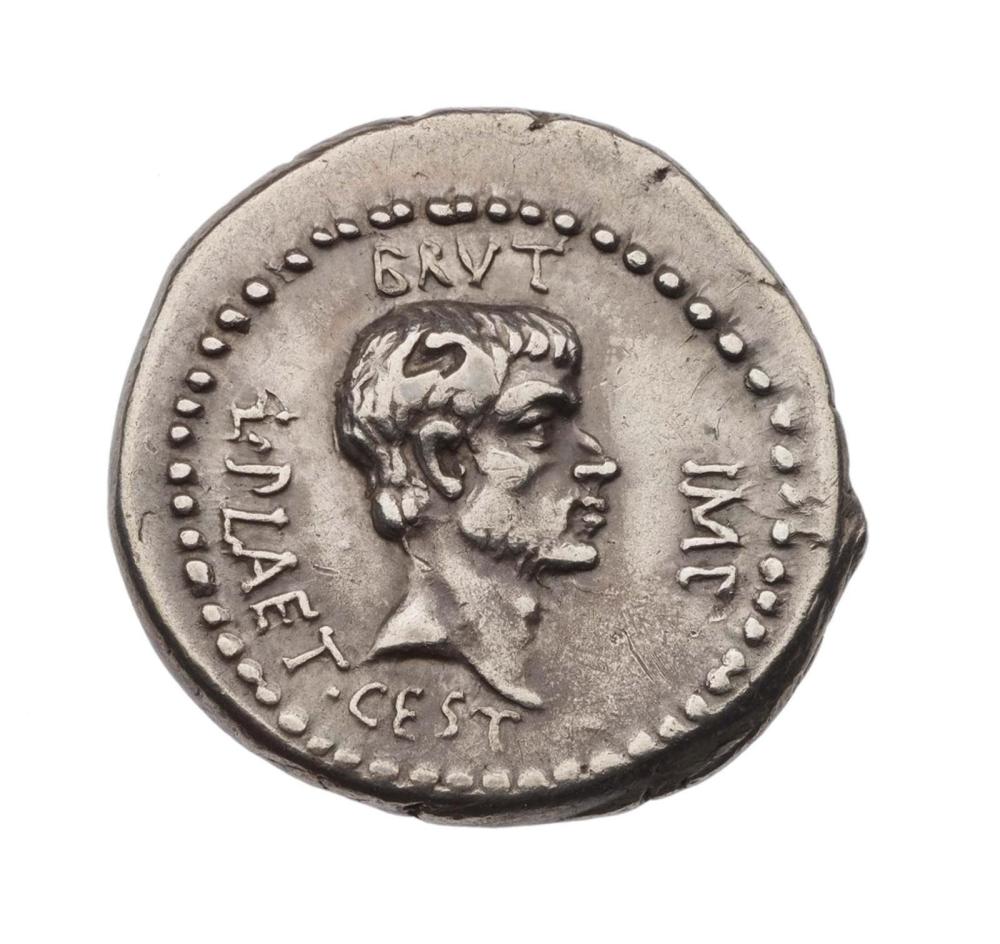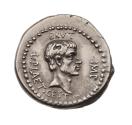Advanced Search
Denarius with head of M. Junius Brutus, struck under L. Plaetorius Cestianus
Roman
Republican Period
43–42 B.C.
Mint: Northern Greece, military mint
Medium/Technique
Silver
Dimensions
Diameter: 19.5 mm. Weight: 3.72 gm. Die Axis: 12
Credit Line
Theodora Wilbour Fund in memory of Zoë Wilbour
Accession Number2002.129
CollectionsAncient Greece and Rome
ClassificationsNumismatics – Coins
Julius Caesar was the first living person whose portrait appeared on a coin struck at Rome. Portraiture on coinage was considered a mark of kingship, a form of government at odds with Roman Republican values. While Caesar never allowed himself to be formally recognized as king, extraordinary honors and privileges had effectively made him the sole ruler of Rome by the mid-40s B.C. To those already concerned about Caesar's growing power, coins issued in early 44 B.C. featuring his portrait would have provided tangible proof of his royal aspirations.
These initial coin portraits of Caesar, showing him with wrinkled neck and sunken cheeks, conform to the stylistic norms of Roman Republican portraiture, which tended to accentuate signs of advanced age. However, certain aspects of Caesar's appearance allude to his exceptional status; for example, he wears a laurel wreath, ordinarily reserved for generals celebrating triumphs but worn by Caesar on all public occasions. The legend "CAESAR DICT QVART" accompanying the portrait head pictured here commemorates Caesar's designation as dictator for the fourth time, an unprecedented extension of authority normally granted for short-term emergencies.
On March 15, 44 B.C., a group of senators, convinced that Caesar intended to dismantle the Roman Republic, stabbed him to death. Brutus, the leader of the conspiracy, soon left Rome to prepare for war with Caesar's supporters. To pay his troops, Brutus issued coins. One of these, a rare denarius whose reverse is shown, presents Brutus's role in the assassination as a strike in defense of freedom from tyranny. A pair of daggers flanks a pileus, a felt cap symbolizing liberty, above the legend "EID MAR," referring to the date of Caesar's death according to the Roman calendar.
These initial coin portraits of Caesar, showing him with wrinkled neck and sunken cheeks, conform to the stylistic norms of Roman Republican portraiture, which tended to accentuate signs of advanced age. However, certain aspects of Caesar's appearance allude to his exceptional status; for example, he wears a laurel wreath, ordinarily reserved for generals celebrating triumphs but worn by Caesar on all public occasions. The legend "CAESAR DICT QVART" accompanying the portrait head pictured here commemorates Caesar's designation as dictator for the fourth time, an unprecedented extension of authority normally granted for short-term emergencies.
On March 15, 44 B.C., a group of senators, convinced that Caesar intended to dismantle the Roman Republic, stabbed him to death. Brutus, the leader of the conspiracy, soon left Rome to prepare for war with Caesar's supporters. To pay his troops, Brutus issued coins. One of these, a rare denarius whose reverse is shown, presents Brutus's role in the assassination as a strike in defense of freedom from tyranny. A pair of daggers flanks a pileus, a felt cap symbolizing liberty, above the legend "EID MAR," referring to the date of Caesar's death according to the Roman calendar.
Catalogue Raisonné
Highlights: Classical Art (MFA), p. 173.
DescriptionObverse: bearded head of M. Junius Brutus, right.
BRVT IMP L · PLAET · CEST
Reverse: Pileus (cap of liberty) between two daggers.
EID · MAR
BRVT IMP L · PLAET · CEST
Reverse: Pileus (cap of liberty) between two daggers.
EID · MAR
ProvenanceBy 1913: with Brüder Egger, Opernring 7, Vienna, Austria (Auktion 43, April 14ff., lot 62); by 1938: with Ars Classica S.A., 23 Quai du Mont-Blanc, Geneva, Switzerland (Auction 18, October 10, 1938, lot 24); by date unknown: Walter Niggeler Collection; by 1966: with Bank Leu & Co. AG, Bahnhofstrasse 32, Zurich and Münzen und Medaillen AG, Malzgasse 25, Basel, Switzerland (auction of the Walter Niggeler Collection, part 2, Malzgasse 25, Basel, October 21-22, 1966, lot 954); by 1980: with Bank Leu & Co AG, Bahnhofstrasse 32, Zurich (Auktion 25, Savoy Hotel - Baur en Ville, Zurich, April 23, 1980, lot 211); by date unknown: Leo Benz Collection; by 1998: with Numismatik Lanz München, Maximilansplatz 10, D-80333 Munich (Auktion 88 of the Leo Benz Collection, November 23, 1998, lot 803); by 2002: with Leu Numismatics Ltd., In Gassen 20, CH-8001, Zurich (Auction 83, Hotel Savoy-Baur en Ville, Poststrasse 12, CH-8001, Zurich, May 6-7, 2002, lot 701); purchased at Auction 83 on behalf of MFA by Harlan J. Berk, Ltd., 31 North Clark Street, Chicago, Illinois 60602; June 26, 2002: purchased by MFA from Harlan J. Berk, Ltd.



